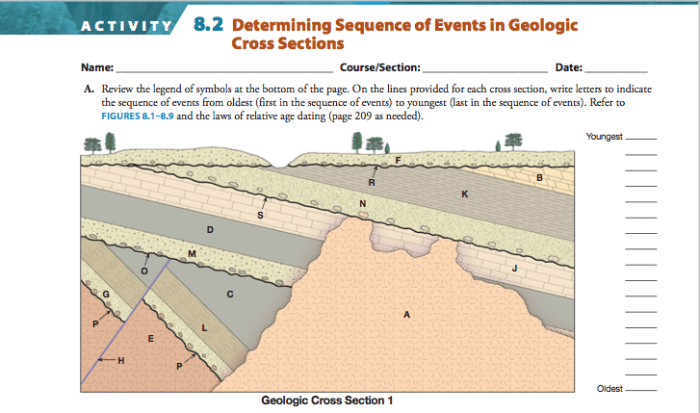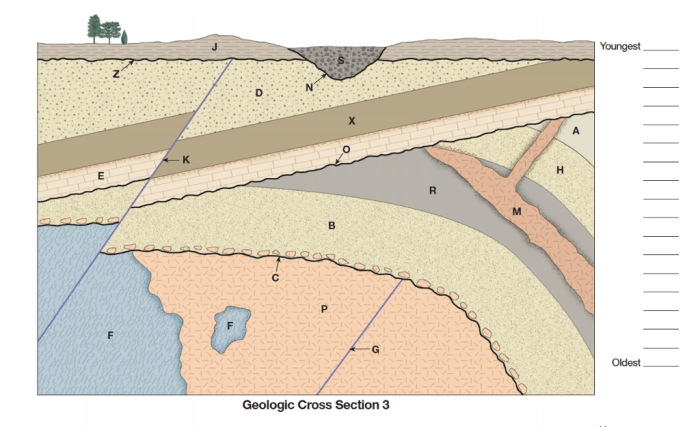Determining sequence of events in geologic cross sections – Determining the sequence of events in geologic cross sections is a fundamental skill in Earth sciences, allowing us to reconstruct the history of our planet. Through careful observation and analysis, we can decipher the complex tapestry of geologic events that have shaped the landscapes we see today.
Geologic cross sections provide a valuable window into Earth’s past, revealing the relationships between different rock layers and structures. By understanding the principles of relative dating and superposition, we can determine the chronological order of events, from the oldest to the youngest.
1. Introduction to Geologic Cross Sections

Geologic cross sections are two-dimensional representations of the subsurface, providing valuable insights into the Earth’s structure and history. They are essential tools for understanding the distribution and relationships of geologic units, faults, folds, and other geologic features.
Types of Geologic Cross Sections
- Surface cross sectionsdepict the topography and geologic features along a line on the Earth’s surface.
- Subsurface cross sectionsextend below the surface, showing the subsurface geology based on well data, seismic surveys, or other geophysical methods.
- Balanced cross sectionsare constructed to restore the cross section to its original, undeformed state, accounting for tectonic forces.
2. Identifying Key Features in Geologic Cross Sections
Geologic cross sections reveal a variety of key features that provide information about the Earth’s history. These include:
Faults
- Dip-slip faults: Vertical or inclined faults where the movement is primarily vertical.
- Strike-slip faults: Vertical or inclined faults where the movement is primarily horizontal.
Folds
- Anticlines: Upward folds where the strata dip away from the axis.
- Synclines: Downward folds where the strata dip towards the axis.
Unconformities
- Angular unconformities: Surfaces that represent a significant time gap and angular discordance between underlying and overlying strata.
- Nonconformities: Surfaces that represent a time gap and an unconformity between igneous or metamorphic rocks and overlying sedimentary rocks.
3. Determining the Sequence of Events in Geologic Cross Sections
The principle of relative dating and superposition is used to determine the sequence of events in geologic cross sections:
Relative Dating
- Superposition: Younger rocks are deposited on top of older rocks, unless overturned.
- Cross-cutting relationships: Younger features, such as faults or intrusions, cut across older features.
Superposition
- In a conformable sequence, strata are deposited continuously without significant breaks or erosional surfaces.
- In an unconformable sequence, there is a significant time gap and/or angular discordance between strata, indicating an interruption in deposition.
4. Constructing a Geologic Cross Section

Constructing a geologic cross section involves the following steps:
Data Gathering
- Collect data from field observations, well logs, seismic surveys, and other sources.
- Identify key features and their locations.
Base Map Creation
- Create a base map with topography, surface features, and any available geologic data.
- Establish a vertical exaggeration to enhance the visibility of geologic features.
Cross Section Interpretation
- Correlate geologic units across the cross section.
- Identify and interpret faults, folds, and unconformities.
- Determine the sequence of events using relative dating and superposition.
5. Applications of Geologic Cross Sections

Geologic cross sections have wide applications in various fields:
Resource Exploration
- Identifying potential hydrocarbon reservoirs and mineral deposits.
- Evaluating the geometry and continuity of ore bodies.
Environmental Studies
- Assessing groundwater flow patterns and contaminant transport.
- Identifying potential sites for waste disposal and remediation.
Engineering, Determining sequence of events in geologic cross sections
- Evaluating the stability of slopes and foundations.
- Designing infrastructure projects, such as tunnels and dams.
FAQ Insights: Determining Sequence Of Events In Geologic Cross Sections
What is the principle of superposition?
The principle of superposition states that in an undisturbed sequence of sedimentary rocks, the oldest layer is at the bottom and the youngest layer is at the top.
How can faults be used to determine the sequence of events?
Faults can be used to determine the sequence of events because they can offset or disrupt rock layers. The fault must have formed after the rock layers were deposited.
What are some limitations of using geologic cross sections to determine the sequence of events?
Some limitations of using geologic cross sections to determine the sequence of events include the presence of unconformities, which can represent gaps in the geologic record, and the difficulty in accurately dating rock layers.